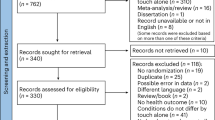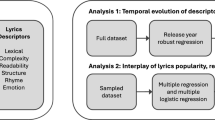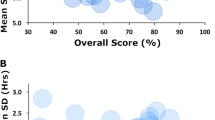Abstract
The dynamics of many social, technological and economic phenomena are driven by individual human actions, turning the quantitative understanding of human behaviour into a central question of modern science. Current models of human dynamics, used from risk assessment to communications, assume that human actions are randomly distributed in time and thus well approximated by Poisson processes1,2,3. In contrast, there is increasing evidence that the timing of many human activities, ranging from communication to entertainment and work patterns, follow non-Poisson statistics, characterized by bursts of rapidly occurring events separated by long periods of inactivity4,5,6,7,8. Here I show that the bursty nature of human behaviour is a consequence of a decision-based queuing process9,10: when individuals execute tasks based on some perceived priority, the timing of the tasks will be heavy tailed, with most tasks being rapidly executed, whereas a few experience very long waiting times. In contrast, random or priority blind execution is well approximated by uniform inter-event statistics. These finding have important implications, ranging from resource management to service allocation, in both communications and retail.
This is a preview of subscription content, access via your institution
Access options
Subscribe to this journal
Receive 51 print issues and online access
$199.00 per year
only $3.90 per issue
Buy this article
- Purchase on Springer Link
- Instant access to full article PDF
Prices may be subject to local taxes which are calculated during checkout



Similar content being viewed by others
References
Haight, F. A. Handbook of the Poisson Distribution (Wiley, New York, 1967)
Reynolds, P. Call Center Staffing (The Call Center School Press, Lebanon, Tennessee, 2003)
Greene, J. H. Production and Inventory Control Handbook 3rd edn (McGraw-Hill, New York, 1997)
Anderson, H. R. Fixed Broadband Wireless System Design (Wiley, New York, 2003)
Dewes, C., Wichmann, A. & Feldman, A. in Proc. 2003 ACM SIGCOMM Conf. Internet Measurement (IMC-03) (ACM Press, New York, 2003)
Kleban, S. D. & Clearwater, S. H. Hierarchical Dynamics, Interarrival Times and Performance. Proc. SC2003 http://www.sc-conference.org/sc2003/paperpdfs/pap222.pdf (2003).
Paxson, V. & Floyd, S. Wide-area traffic: The failure of Poisson modeling. IEEE/ACM Trans. Netw. 3, 226 (1996)
Masoliver, J., Montero, M. & Weiss, G. H. Continuous-time random-walk model for financial distributions. Phys. Rev. E 67, 021112 (2003)
Cobham, A. Priority assignment in waiting line problems. J. Oper. Res. Sec. Am. 2, 70–76 (1954)
Cohen, J. W. The Single Server Queue (North Holland, Amsterdam, 1969)
Eckmann, J.-P., Moses, E. & Sergi, D. Entropy of dialogues creates coherent structure in e-mail traffic. Proc. Natl Acd. Sci. USA 101, 14333–14337 (2004)
Ebel, H., Mielsch, L. I. & Bornholdt, S. Scale-free topology of e-mail network. Phys. Rev. E 66, R35103 (2002)
Harder, U. & Paczuski, M. Correlated dynamics in human printing behavior. Preprint at http://xxx.lanl.gov/abs/cs.PF/0412027 (2004).
Henderson, T. & Nhatti, S. Modelling user behavior in networked games. Proc. 9th ACM Int. Conf. on Multimetia 212–220 (ACM Press, New York, 2001).
Crovella, M. & Bestravros, A. Self-similarity in World Wide Web traffic: evidence and possible causes. IEEE/ACM Trans. Netw. 5, 835–846 (1997)
Mitzenmacher, M. A brief history of generative models for power law and lognormal distributions. Internet Math. 1, 226–251 (2004)
Miller, G. A. The magical number seven, plus or minus two: Some limits on our capacity for processing information. Psychol. Rev. 63, 8197 (1956)
Bak, P. & Sneppen, K. Punctuated equilibrium and criticality in a simple model of evolution. Phys. Rev. Lett. 71, 4083–4086 (1993)
Jensen, H. J. Self Organised Criticality (Cambridge Univ. Press, Cambridge, 1998)
Park, K. & Willinger, W. Self-Similar Networks Traffic and Performance Evaluation (Wiley, New York, 2000)
Leighton, F. T., Maggs, B. M. & Rao, S. B. Packet routing and job-shop scheduling in O(congestion + dilation) steps. Combinatorica 14, 167–186 (1994)
Harris, C. M., Brill, P. H. & Fischer, M. J. Internet-type queues with power-tailed interarrival times and computational methods for their analysis. INFORMS J. Comp. 12, 261–271 (2000)
Eubank, H. et al. Controlling epidemics in realistic urban social networks. Nature 429, 180–184 (2004)
Manrubia, S. C., Zanette, D. & Sole, R. V. Transient dynamics and scaling phenomena in urban growth. Fractals 7, 1–8 (1999)
Helbing, D., Farkas, I. & Vicsek, T. Simulating dynamic features of escape panic. Nature 407, 487–490 (2000)
Caldarelli, G., Marsili, M. & Zhang, Y.-C. A prototype model of stock exchange. Europhys. Lett. 40, 479–484 (1997)
Kleinberg, J. in Proc. 8th ACM SIGKDD Intl Conf. Knowledge Discov. Data Mining, 91–101 (2002)
Viswanathan, G. M. et al. Optimizing the success of random searches. Nature 401, 911–914 (1999)
Acknowledgements
I have benefited from discussions with A. Vazquez on the mathematical aspects of the model. I also thank L. A. N. Amaral, Z. Dezsö, P. Ivanov, J. Kelley, J. Kertész, A. Motter, M. Paczuski, K. Sneppen, T. Vicsek, W. Whitt and E. Zambrano for useful discussions and comments on the manuscript; J.-P. Eckmann for providing the e-mail database; and S. Aleva for assisting me with manuscript preparation. This research was supported by NSF grants.
Author information
Authors and Affiliations
Corresponding author
Ethics declarations
Competing interests
The author declares that he has no competing financial interests.
Supplementary information
Supplementary Notes
This file contains additional notes and discussions relating to the study, including information on: queuing theory, calculating P(τ) for the priority list model, random removal limit of the priority list model, power law generating processes and mapping to evolutionary models. This file also contains additional references. (PDF 179 kb)
Rights and permissions
About this article
Cite this article
Barabási, AL. The origin of bursts and heavy tails in human dynamics. Nature 435, 207–211 (2005). https://doi.org/10.1038/nature03459
Received:
Accepted:
Issue Date:
DOI: https://doi.org/10.1038/nature03459
This article is cited by
-
The impact of toxic trolling comments on anti-vaccine YouTube videos
Scientific Reports (2024)
-
Bursts of communication increase opinion diversity in the temporal Deffuant model
Scientific Reports (2024)
-
Human emergency behaviour and psychological stress characteristic mining based on large-scale emergencies
Computational and Mathematical Organization Theory (2024)
-
Common multi-day rhythms in smartphone behavior
npj Digital Medicine (2023)
-
Temporal visitation patterns of points of interest in cities on a planetary scale: a network science and machine learning approach
Scientific Reports (2023)
Comments
By submitting a comment you agree to abide by our Terms and Community Guidelines. If you find something abusive or that does not comply with our terms or guidelines please flag it as inappropriate.



